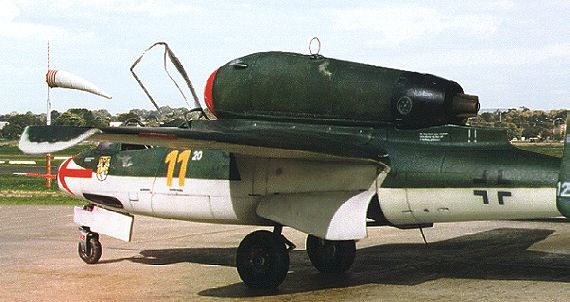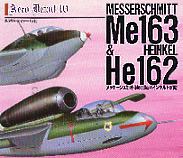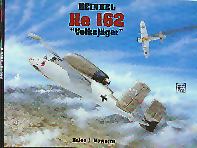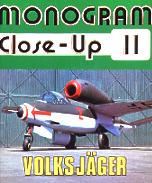|
Heinkel He 162 |
|
Heinkel He 162 |
B a c k g r o u n d |
The official name given to what I nickname the Humpback was the Heinkel He162 Salamander. It was popularly promoted by the Reich war ministry as the "Volksjager" ( People's Fighter ) as one of the many technically advanced secret weapons that was hoped would help bolster the then despairing German public. Designed and built in the remarkable short time of just three months this high-performance fighter was a composite of mainly wood and steel due to dire raw material shortages. It was built by relatively unskilled labour and was to be flown by novice pilots.

The protype first flew in Dec.1944 and subsequent
testing and operational units established in early 1945 with the first of only a few
combat missions ordered, "as far as is known on April 26, 1945 ; engagement of low
flying aircraft". 9 days later the war ended. It was reported that due to the
disruptive bombing by the allies only about 100 were completed although many were in an
advanced state of assembly in underground factories at the end of the war.
A dictionary description of Salamander is a mythical creature, generally resembling a
lizard, believed capable of living in or withstanding fire. Whether it applied to the
naming of the He162 is not known.
M o r e I m a g e s |
Click on any of the thumbnails to view the full-sized image. Click on the back arrow of your broser to return to this page.
Despite having three excellent photo / text manuals I am only 90 % certain of the correct exterior shading simulating what was wood and what was metal. Doubt arises about the oval shaped "wing root stiffening plates" which I suspect were metal ? However I am quite definite that virtually all the vertical stabilizers (end caps and middle brackets were sheet metal), and landing gear doors were made or at least covered in plywood. The 2 slots in the wood colored panel immediately behind the cockpit is Dragon's overly simplistic canopy hinge molding.
Detailed landing gear containing photoetch parts supplied with the kit. The landing struts, tyres and retraction mechanism were based on Bf109K design but a unique spring loaded system was used to flick the landing gear open, "with a great thwack" I remember reading somewhere.
The paint scheme is based on an aircraft of 3/G1 flown by Oblt. Emil Demuth's, which was surrendered at Leck airbase, May 1945. The black, white and red nose markings signal a commander's aircraft. The He162 is one of the rare aircraft flown during WWII that had an ejection seat fitted. An explosive charge was used as the firing system.
Birds-eye view of the simple symmetry of the Salamander. The Heinkel He162 jet aircraft had a maximum speed of 840 km/h (520m/h).
My first reference for this exact aircraft was the enlightning box art painted by Shigeo Koike on Dragon's 1/72 He162 version. I used this to copy the scuffed paint markings on the port cockpit external wall and on the jet engine cover near the round aerial mount. Schiffer's photo booklet has a full page well defined BW photograph of the same aircraft to affirm the worn paint marks.
Note the the orange-yellow colored wing fuel filler caps. They are attributed to Shigeo Koike. He pointed out these colorful details on his He162 paintings.
R e f e r e n c e s |
 Aero Detail # 10
"Me 163 & He162", Japanese Publication with bilingual text Full Color Detail
Photos.
Aero Detail # 10
"Me 163 & He162", Japanese Publication with bilingual text Full Color Detail
Photos.
 Schiffer Publication Heinkel He162 "Volksjager"
, B/W.
Schiffer Publication Heinkel He162 "Volksjager"
, B/W.
 Monogram Publication "Close-Up # 11,
Volksjager", Color.
Monogram Publication "Close-Up # 11,
Volksjager", Color.
Model, Text and Photograph Copyright © 1998 by Chris Beaumont
Page Created 28 August 1998
Last updated 26 July 2007
Back to HyperScale Main Page
Back to Feature Articles
To Chris Wauchop's He 162 in The Gallery